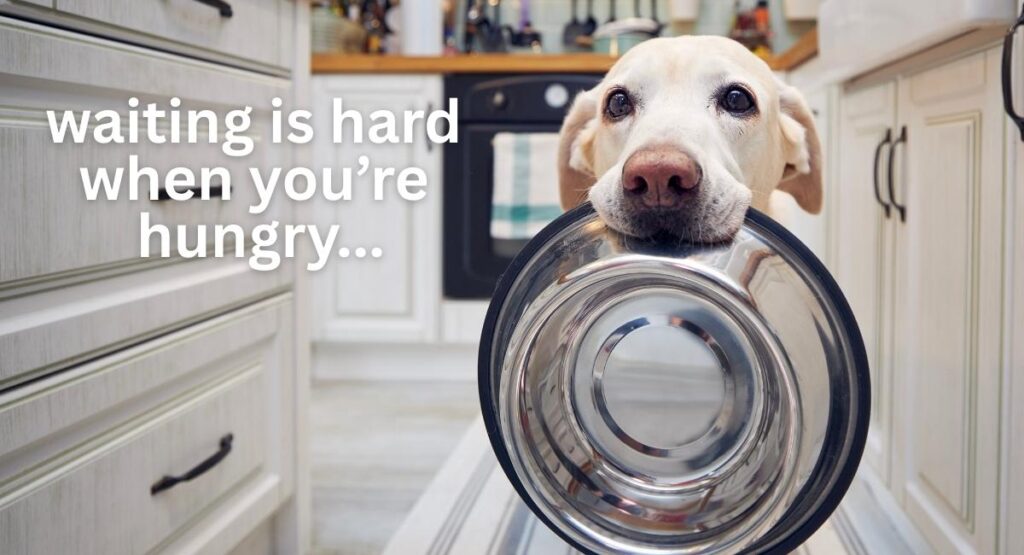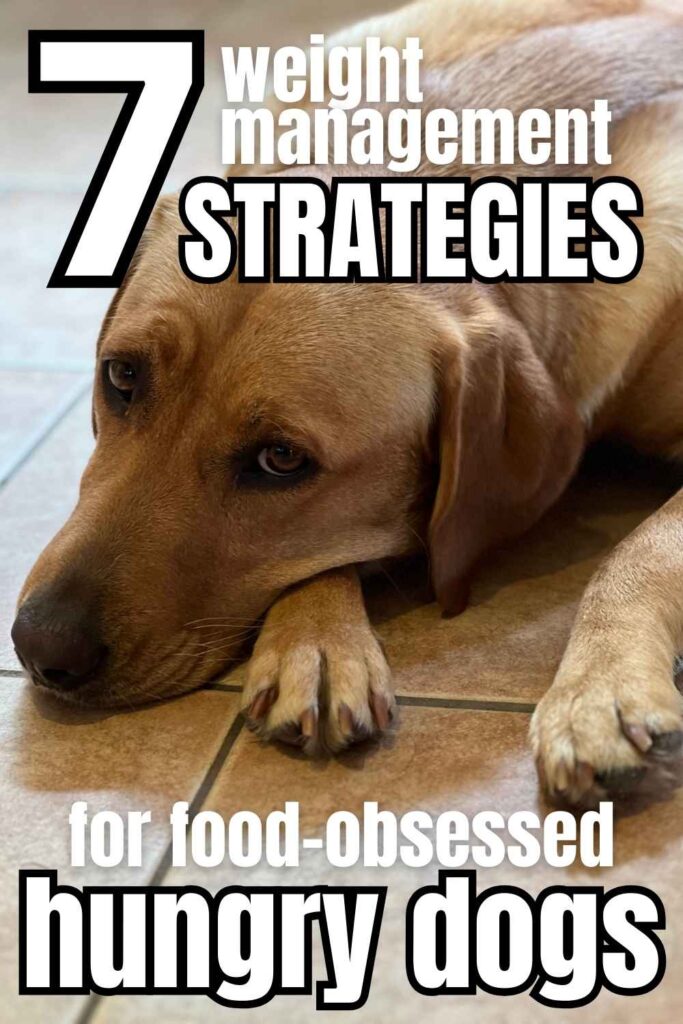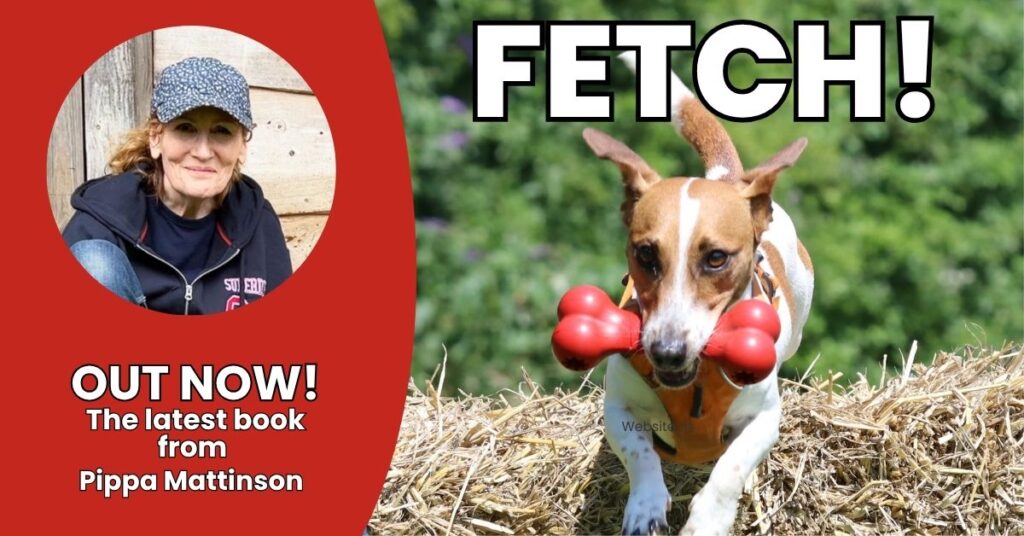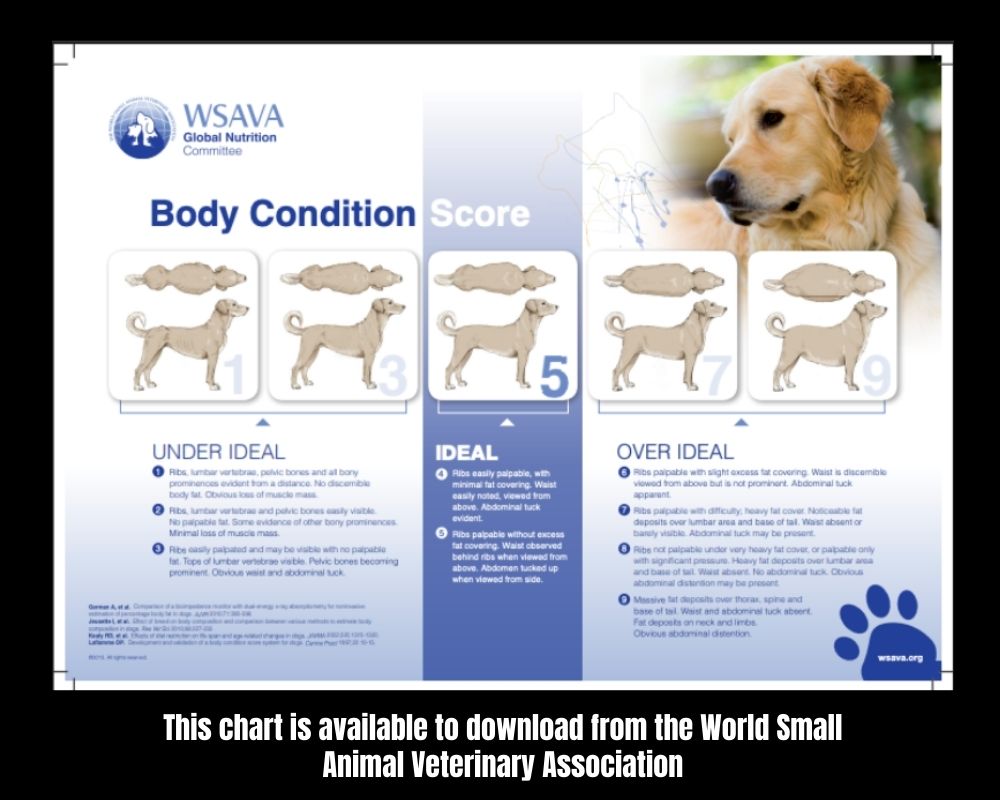Strategies for Managing Weight in Food-Obsessed Dogs (With Printable Progress Charts & Games)

Weight gain is sneaky. It creeps up when we are not looking. And our dogs are no different from us in that respect.
You live with your dog every day and you probably won’t notice weight gain that happens slowly over many months.

So you mustn’t be too hard on yourself if you wake up one morning and realise your slender gawky six month old Lab, is now a rather porky three year old.
Or too shocked if your veterinarian takes you quietly to one side and says ‘we need to have a chat about junior’s diet. . ’
It’s ok, we can fix this!
We have lots of information on reducing your dog’s calorie intake in this article. But today we have some great strategies to help you, that go beyond food management.
So let’s not waist (sorry) any more time. Here are seven practical strategies for managing your food-obsessed Labrador’s weight.
#1 Know The Score – How Plump Is Too Plump?
The first thing we need to do, is make an honest appraisal of the problem! What are we starting with?
Is this a seriously overweight dog, or just minor issue?
Back in 1997, a scientist came up with the idea of a body condition score for dogs. Body condition scores are not new, shepherds have been using them for sheep since forever. And they are actually really useful.
With dogs we can go further than just looking, and run our hands over the dog. But the general idea is that you can roughly gauge the condition of an animal by simply looking at their outline. And allocate that outline a score.
On a scale of 1 to 9 a slim, healthy dog will be a 5. A starving and emaciated dog will have a score of 1. While a grossly overweight dog will be a 9
I’ll explain a bit more about the score, but this is not about pin point accuracy, so don’t agonise about whether your dog is a 6 or a 7.
Even experts will get disagree. However, the system has been shown to be reasonably accurate to the point where dogs allocated a certain score by one person, are likely to be given the same or a similar score by other people.
So while this is a guide rather than an exact measurement, it’s a useful, and reasonably consistent one. It’s also a quick way of assessing a dog at a glance. And a reference for you to judge how much progress you have made with helping your dog in the future
I recommend you now take a closer look at this chart from the World Small Animal Veterinary Association, and allocate your dog with a starting score. It’s pdf document so you can download and print it out if you want to.
The important thing is to make a note of your dog’s score today, and come back to it in a month’s time to see if things have improved.
If you are confident that your dog is already a five, then our work here is done! Otherwise, let’s move on to strategy number two.
#2 Build Interesting Activity Habits
Maybe your dog already gets a lot of exercise. Many overweight dogs do. And the truth is, at the heart of the weight problem there is always a food problem.
But that doesn’t mean exercise isn’t important.
Getting your dog up and moving regularly throughout the day is critical. Not just because exercise burns up some of that food. But also because it reduces boredom and helps your dog relax and forget about food for a while!
Regular exercise doesn’t have to mean a five mile run, or a boring walk to the end of the street and back. It means getting your dog running around, on a regular, consistent basis.
The idea is to create activity sessions that you enjoy too. So that you are motivated to keep doing them with your dog.
There are even ways to exercise your dog while you stand still if you want to. Either by training your dog to fetch or run out to a target. Or by inviting another dog around for a play date. This isn’t cheating. It’s still exercise (for your dog at any rate)
Examples of fun ways to get your dog moving include
- Playing fetch
- Playing with another dog
- A training session
- Swimming in a pool or the ocean
- An early morning run
If you live in a region where it’s too hot or too cold for your dog to be outside for parts of the year, you can even buy a doggy treadmill to help your friend notch up a few miles.
Whatever method you choose, the secret is to build these exercise sessions into your routine.
Write them down, or put them in your smartphone calendar and set an alert to remind you to do them. Twice a day is great. Three times a day is brilliant. And once a day is better than nothing. But it does need to be daily.
#3 Make Food More Fun
It’s shocking how quickly food disappears from a hungry dog’s bowl. It’s there and then it isn’t.
A food obsessed dog can devour a seriously large bowl in a very short space of time. Definitely less than five minutes.
If you feed your dog once a day, that just leaves the remaining 23 hours and 55 minutes of the day to get through until the next mealtime… It doesn’t sound like much fun.
Fortunately there are lots of great ways to expand on the enjoyment your dog gets from food, including
- Puzzle toys
- Scatter feeding
- Treat dispensers
- Snuffle mats
- Slow feeders
It goes without saying that none of these activities should use food that is additional to what goes in your dog’s dinner bowl.
You don’t need to buy special treats to fill a treat dispenser, just take food from your dog’s daily allowance. This is a different way of feeding a dog, not a way to get even more food into them!
#4 Train That Doggy Brain
Training does far more than improve your dog’s manners. It also makes dogs mentally tired and like physical exercise, helps to relax them afterwards.
Here are a few useful and fun ideas for things to teach your dog, from the very simple, to the more complex
- To touch your hand
- To unlock your hand
- To wipe their paws
- To get into a crate or bed on your command
- To find a hidden toy
- To pick up your car keys
Here’s a video of the ‘Hand Touch’ game.
The ‘unlock game’ instructions are on my Dogsnet Training website.
You can download the ‘Wipe Your Paws’ game as a PDF and print it out. You’ll find instructions for teaching a dog to pick up and fetch toys and other items in my book: Fetch. And you’ll find lots more ideas and games on the Dogsnet Training website.
If you measure out your dog’s daily food allowance at the beginning of each day, then you can simply take from that allowance for each activity, and feed what’s left in a bowl at the end of the day.
In fact it’s fine for all your dog’s food allowance to be used up this way if you have time to do so.
#5 Keep A Log
Logging your dog’s progress towards a fitter, healthier life is a great way to motivate you. And to help keep other family members on board with your goals.
I’ve included some printable log sheets for you to print out and pin on the kitchen noticeboard or refrigerator
Weight log: If you have suitable scales at home, you can keep a dog weight log. This is a great way to make sure your Lab is making progress towards your target weight for them.
If you want to buy a set of your own dog scales(paid link) rather than wait for your next vet visit, make sure that the platform on the scales is big enough for your dog. Both in maximum weight capacity and actual size
Please note that the link above is an affiliate link and if you make a purchase after clicking on it, the Labrador Site receives a small payment which does not affect the price you pay.
Waist log: If scales aren’t an option, a simple way to check progress with a very overweight dog is to measure their girth. Run a tape measure around your dog’s belly just in front of their hips and record the number of inches. This should come down gradually as their waist reappears
Exercise: Keeping a record of what you did today that got your dog moving, even for just a few minutes, is a good way to keep you motivated and make sure there are no gaps in your chart!

Remember, there are lots of great ways to exercise your dog. A game of fetch, a swim in the pool, playing with another dog, and training sessions at home in the yard all count as long as the dog is moving around.
#6 Make a ‘No Human Food’ Rule
Don’t underestimate the challenge. This is tough. Resisting puppy dog eyes is tough. Turning away from a gently wagging tail is tough.
But a No Human Food rule is critical in determining your chances of making your dog healthy again. Sharing human food instantly adds unwanted calories to your dog’s daily intake. No-one, but no-one, shares their food with a dog then rushes to subtract those calories from the dog’s daily kibble allowance. It just doesn’t happen
And the bottom line is that dogs that maintain a lean body weight live two years longer than dogs that are overweight.
That’s two whole years.
And the only person that can make that lean body weight happen, is you.
So write the rule down. Show it to the family. Put it up on the wall in BIG letters. Your dog’s health depends on it.
#7 Partner With Your Veterinarian
To help you with all this, you have a great ally. Your dog’s veterinarian will not only support and advise you on helping restore your dog to good health, they’ll be able to check that there is nothing else going on that you need to know about.
Because while most overweight dogs are simply overfed, there are some medical conditions that can contribute to weight gain. Especially if that weight gain is unexplained by diet or comes on rapidly.
So before you start your doggy health project, a visit to the veterinarian is a great idea. And scheduling another check up in six weeks or so will help keep you accountable and may increase your chances of success.
You Can Do This
I hope you find these strategies helpful. Labrador appetites are legendary, and some even have a gene that makes them extra hungry. But remember that you hold all the cards.
Your dog cannot open the food cupboard, or grab a snack from the refrigerator, so you can definitely make this happen. Good luck, and let me know what worked best for you, in the comments below!

Free Labrador Updates!
Get my training tips, news, reviews, and the latest from The Labrador Site delivered to your inbox






